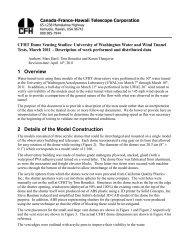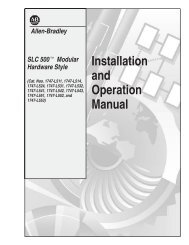Documentation [PDF] - Canada France Hawaii Telescope ...
Documentation [PDF] - Canada France Hawaii Telescope ...
Documentation [PDF] - Canada France Hawaii Telescope ...
Create successful ePaper yourself
Turn your PDF publications into a flip-book with our unique Google optimized e-Paper software.
Wide Field Magnitude range u ∗ g r i y z<br />
[MegaCam AB] [mag.] [mag.] [mag.] [mag.] [mag.] [mag.]<br />
W1 [19.0 − 20.0] 0.002 0.002 0.003 0.006 0.003 0.008<br />
[20.0 − 21.0] 0.005 0.003 0.010 0.007 0.007 0.017<br />
[21.0 − 22.0] 0.008 0.009 0.011 0.016 0.014 0.043<br />
[22.0 − 23.0] 0.020 0.015 0.025 0.037 0.035 0.098<br />
[23.0 − 24.0] 0.046 0.035 0.061 0.089 0.083 0.159<br />
W2 [19.0 − 20.0] 0.002 0.002 0.003 0.003 - 0.009<br />
[20.0 − 21.0] 0.004 0.004 0.005 0.007 - 0.018<br />
[21.0 − 22.0] 0.009 0.009 0.012 0.016 - 0.041<br />
[22.0 − 23.0] 0.020 0.016 0.027 0.038 - 0.097<br />
[23.0 − 24.0] 0.050 0.038 0.067 0.087 - 0.161<br />
W3 [19.0 − 20.0] 0.002 0.001 0.002 0.003 0.002 0.008<br />
[20.0 − 21.0] 0.004 0.003 0.005 0.007 0.007 0.018<br />
[21.0 − 22.0] 0.008 0.007 0.011 0.017 0.015 0.040<br />
[22.0 − 23.0] 0.020 0.015 0.025 0.039 0.034 0.095<br />
[23.0 − 24.0] 0.049 0.035 0.060 0.094 0.084 0.140<br />
W4 [19.0 − 20.0] 0.002 0.001 0.002 0.003 0.003 0.009<br />
[20.0 − 21.0] 0.004 0.003 0.005 0.007 0.007 0.019<br />
[21.0 − 22.0] 0.008 0.007 0.013 0.017 0.015 0.044<br />
[22.0 − 23.0] 0.020 0.015 0.028 0.041 0.035 0.098<br />
[23.0 − 24.0] 0.049 0.035 0.057 0.094 0.088 0.142<br />
Table 8: Internal photometric errors per magnitude bins derived for each CFHTLS Wide field. The simulated<br />
sources include only stars and are detected and analyzed in the same was as real sources. The errors are the<br />
FWHM/2.35, as shown in Fig. 34. They are corrected from the amplitude of the tilt from horizontal of the difference<br />
between of the input and output magnitudes as function of magnitude inside the bin. The magnitude ranges quoted<br />
in the table only comprise bins with all sources below the completeness limits and with all sources having a signalto-noise<br />
ratio larger than 10. The W2 y-band is not quoted because it only concerns two stacks and the statistics<br />
are meaningless for these fields.<br />
4.4.2 Error estimation from overlapping Wide tiles<br />
An estimation of the internal photometric errors of the Wide survey can also be made using common<br />
sources in overlapping tiles. Since each tile is shifted by 56 ′ in RA and 57 ′ in DEC with respect to its<br />
nearest tiles overlap regions are stripes of 4 ′ × 60 ′ or 3 ′ × 60 ′ (see Fig. 21). We use the u ∗ , g, r, i and<br />
z-band MAG_IQ20 stars located in these regions to compare the photometry of sources detected in two<br />
adjacent stacks. The analysis is restricted to stars to avoid the specific issues involved in the use of<br />
MAG_AUTO for galaxies. Furthermore, it can only be applied on thin strips located at the edges of images<br />
where sources have lower signal-to-noise due to the adopted dithering strategy; therefore, this analysis<br />
should be regarded as secondary to our previous simulation-based estimations.<br />
The first estimate of internal errors is derived by calculating for each pair of overlapping tiles the median<br />
of the magnitude differences of all source pairs in the overlapping regions. This value is the field to field<br />
photometric offset between the two contiguous tiles. For a complete Wide patch, the standard deviation<br />
48


![Documentation [PDF] - Canada France Hawaii Telescope ...](https://img.yumpu.com/26965302/60/500x640/documentation-pdf-canada-france-hawaii-telescope-.jpg)









